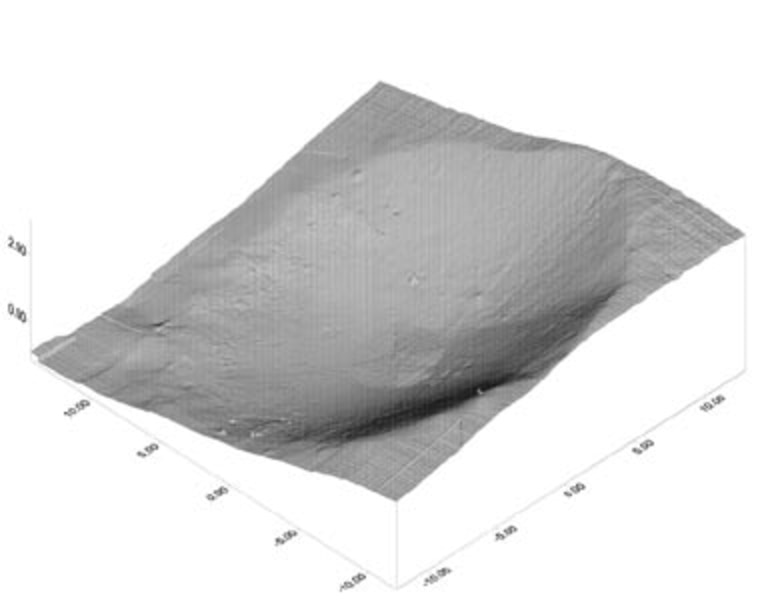NASA’s Mars rover Opportunity has spied hints of a mineral that typically forms in water — a finding that could mean the dry and dusty Red Planet was once wetter and more hospitable to life.
That is the very question Opportunity and its twin, Spirit, were sent to answer.
The preliminary discovery came on Friday, hours before Opportunity was to roll its six wheels onto the Martian surface for the first time. Engineers planned to command the rover to roll the 10 feet off its lander and onto Mars at 3:30 a.m. ET Saturday. Confirmation was expected three hours later.
NASA said the $820 million double-barreled mission should begin in earnest by Sunday, once Opportunity is on the ground and Spirit, on the other side of the planet, is cured of the software problems that have crippled it for more than a week.
“The fat lady has finally gotten onto the stage, but the time of her aria has not yet arrived,” project manager Pete Theisinger said at NASA’s Jet Propulsion Laboratory.
The rovers face continuing perils, including bitter cold and rough terrain.
Looking for hematite
NASA scientists want Opportunity to find on the pebbly ground a mineral called gray hematite. The iron-rich mineral typically — but not always — forms in liquid water.
Scientists said the preliminary evidence suggests Opportunity has already spied the mineral in the ruddy soil around it by using its mini-thermal emissions spectrometer, or Mini-TES, an instrument that measures infrared radiation.
Confirmation should take a few days, while scientists check and double-check their data, said Ray Arvidson of Washington University, the deputy main scientist for the mission.
Even when pressed, Arvidsen declined to confirm that gray hematite had been detected. “But if you look at any Mini-TES team members, they have huge smiles on their faces,” he added.
The detection of gray hematite would not be a huge surprise, because orbital data have indicated that the area where Opportunity landed, in Meridiani Planum, is rich in the iron oxide mineral. Scientists believe the mineral covers an estimated 15 percent to 20 percent of the surface across an area hundreds of miles across. That's the very reason why Meridiani Planum was selected as Opportunity's destination.
A closer analysis of the rover's surroundings could help scientists determine whether the hematite was formed through interaction with liquid water or through volcanic processes. Those findings, in turn, would provide evidence for or against the theory that ancient Mars had liquid water for an extended period of time. On Earth, life has been found virtually anywhere liquid water exists.

Using readings from Opportunity's cameras, scientists developed a 3-D contour map of the crater in which the rover rests — marking the first time a spacecraft has mapped a crater from the inside. However, the mission team hadn't yet determined exactly where the crater is located on orbital maps. “It’s a different position from where we thought we were,” Arvidsen said.
Opportunity has completed a panoramic view of its surroundings, and that should be transmitted to Earth over the next couple of days, said Daniel Limonadi, a rover systems engineer at JPL.
Once Opportunity leaves its landing platform, scientists want the rover to strike out for an outcropping several yards to its left. High-resolution images have revealed the presence of fine layers in the bedrock. The layers could have been laid down by water, wind or the buildup of volcanic ash.
Eventually, scientists plan to steer Opportunity out of its crater to explore the plain beyond.
Spirit's schedule
As for the ailing Spirit rover, half a world away, NASA deleted 1,700 files from its flash memory Friday and then rebooted the rover.
“I am pleased to report it appears to be working just fine,” said Glenn Reeves, chief engineer for the rover’s flight software. He said NASA should be able to declare Spirit “fully recovered” by Sunday.
Cornell University astronomer Steve Squyres, the mission’s main scientist, said very little science will have been lost because of the setback. Squyres previously warned that each rover would probably lose one of every three days of work to unforeseen circumstances.
While on the mend, Spirit already has resumed its science work at Gusev Crater, snapping the first-ever microscopic image taken on Mars of the surface of a rock. Spirit should begin drilling into the rock, dubbed Adirondack, sometime in the next four days.
Initial measurements reveal the rock is an olivine-rich basalt. The volcanic rock is the most common type on the surface of Earth and does not require water to form. That disappointed scientists.
“It is not the kind of smoking-gun evidence we’re looking for,” Arvidson said.
NASA also showed new images taken by the rover’s panoramic camera of rocks that have been nicknamed Cake and Blanco.
